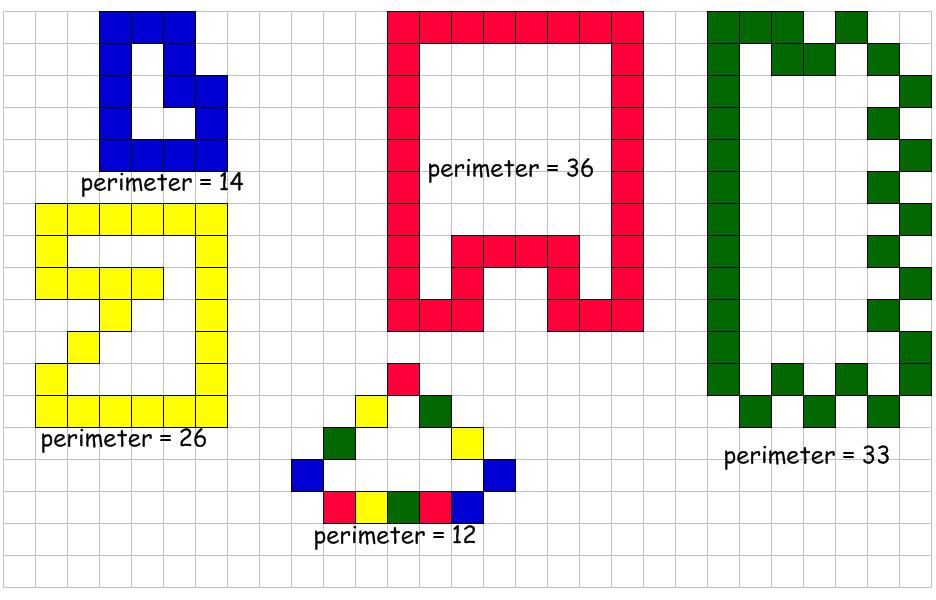Room 310 Gauchos- Ferguson EDT610
Education is not the filling of a pail, but the lighting of a fire. William Butler Yeats
Friday, March 28, 2014
Post Your Perimeter Problems HERE!
This is the place to post the math problem that you created. Don't forget to have fun solving your classmates problems too!
Math Lesson on Perimeter
Essential
Question
How
can finding the perimeter of an object inform your decision making process?
Common
Core State Standard Third Grade - 3.MD.D.8
Solve real world
and mathematical problems involving perimeters of polygons, including finding
the perimeter given the side lengths, finding an unknown side length, and
exhibiting rectangles with the same perimeter and different areas or with the
same area and different perimeters.
Introduction
You’ve already
learned about the different types of polygons and also how to measure objects
using inches and centimeters. Now it’s
time to combine these two concepts as we learn how to find the perimeter of
objects.
WHY would YOU
ever WANT to find the perimeter of an object?
You’re going to investigate this question to find out how people use
their knowledge of perimeter in real life situations. Now it’s time to get to work! Watch the following YouTube video about
perimeter and area.
(If the video doesn't play on your tablet, here's the video link.)
Now that you
know a little more about finding the perimeter, follow the link below to our Padlet Wall and post your answer to the following questions:
How do people use their knowledge of perimeter in their
everyday lives? Why might you need to
find the perimeter of an object?
Task
After studying
different lessons on perimeter, your task will be to create a real life math
problem for your classmates.
They will need to use their perimeter skills to solve the problem. This math problem needs to be complex and
challenging, not too easy. Also, you
will need to provide your classmates with just the right amount of information
to solve the problem. To ensure that you
will understand your classmates’ responses, you will need to find two different
ways to solve your math problem.
Each student
will post their math problem on the class blog.
Authors will email their two solutions to the teacher. Then, classmates can solve each others’
problems and receive feedback from the creator.
Lesson
Resources
Lesson
Process
First, go to the
Pearson
Sign-In Page . Your user name is
“primary.student”. Your password is
“Welcome1”.
Now, complete the
two lessons on perimeter. Each lesson
has 5 parts – an interactive lesson, guided practice, independent practice,
problem solving, and a quiz. Don’t
forget to play the perimeter game after you have completed both lessons.
Next, watch the Real World Geometry Video
to see examples of finding the perimeter of real objects.
Last, you will
investigate other perimeter resources.
You can choose from the lesson resource links or, with your parents
help, find other perimeter resources on your own. Don’t forget our Internet safety rules. To review the rules, watch this Presentation
on Good Digital Citizenship. Continue
learning about perimeter until you feel comfortable with the concept and are
ready to apply your knowledge by completing the following assignments.
Assignments
Now it’s time
for you apply your skills by solving some real world perimeter problems. Click here to download the problems.
After completing
them, you can check your own work using this Answer Key.
Finally, you are
ready to create your own real life perimeter problem. This problem needs to be challenging, not too
simple. Your problem should provide
enough information to solve it, but make the student think and use other math
skills in the process. You must also
find two different ways to solve
your problem and explain them in writing.
Use the grading rubric below to help you evaluate your perimeter
problem.
Lastly, you will
post your perimeter problem on the
class blog for your classmates to solve.
Email your solutions to joni.ferguson@leusd.k12.ca.us. Don’t forget to have fun solving other
problems created by your classmates too!
Grading
Rubric
Your real world
perimeter problem and two solutions will be graded using the following rubric.
Extension
Now that you’ve
completed this lesson on finding the perimeter, you are prepared to apply this
skill in your real life, whether you are buying supplies to build a fence or
decorating the border of your classroom bulletin board. How does knowledge of perimeter inform our decision making process?
As you studied
perimeter, you probably noticed that many of the resources also discussed
finding the area of an object. For
further study, answer the following questions:
1. How do you find the area of an object?
2. What is the difference between area and
perimeter?
3. Can two objects have the same perimeter, but
different areas? Or the same area, but
different
perimeters?
4. How do people use area in the real world?
Subscribe to:
Posts (Atom)



